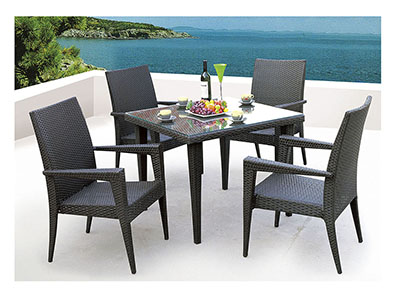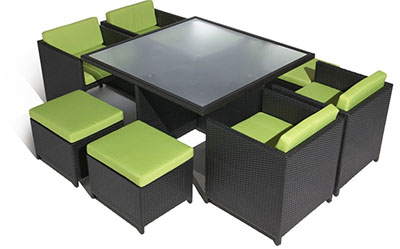Everywhere around the world, RFID tags (RFID tags) technology are focused on and predict its growth. Can RFID tags replace bar codes? Let's analyze the advantages and disadvantages of RFID technology.
1. Introduction to RFID
1) What is RFID?
RFID is an abbreviation for Radio Frequency Identififieation, ie, radio frequency identification. It is also often referred to as inductive electronic chip or proximity card, proximity card, contactless card, electronic tag, electronic bar code, and the like. It is a hybrid technology that transfers information and exchanges information over radio waves.
2) How RFID works
The reader sends a radio frequency signal of a certain frequency through the antenna. When the tag enters the magnetic field, it generates a sense current to obtain energy. Sending its own code and other information is read and decoded by the reader and sent to the host computer for processing.
3) Composition of RFID
The RFID system consists of three parts: Tag: It consists of a coupling element and a chip. Each tag has a unique electronic code and is attached to the object to identify the target object.
Reader: A device that reads (sometimes writes) tag information. It can be designed to be handheld or stationary: Antennas transmit RF signals between tags and readers. The antenna is usually made by stamping or etching metal coils. It can be formed by rolling with aluminum foil, or the conductive ink can be directly printed on the substrate. Conductive inks can be used to connect components of the tag to act as sensors or antennas.
The conductive ink for RFID tags is composed of fine conductive particles or other special materials (such as conductive polymers, etc.). After printed on the substrate, it acts as a wire, antenna, and resistor. Today, the use of conductive inks in high-speed printing to produce RFID-tag antennas offers outstanding advantages.
In addition, conductive inks save the cost of RFID tags in two ways. First of all, from the material cost, the ink is cheaper than stamping or etching metal coils. Secondly, from the aspect of material consumption, medium voltage or etching consumes a lot of metal, while the conductive ink prints an antenna or circuit with high speed. Low, high efficiency.
4) RFID tag classification
RFID tags are classified into passive tags and active tags. The active tag itself is battery-powered, has a long read/write distance and is relatively bulky, and is more expensive than a passive tag, also referred to as an active tag. Passive tags get the energy required by the reader from the magnetic field generated by the reader. The cost is low and they have a long service life. They are smaller and lighter than the active tags, and the read and write distances are relatively close. They are also called passive tags. .
2 RFID tag system operating frequency
The RFID device has a certain range, and LF, HF, and UHF correspond to radio frequencies of different frequencies. LF stands for low-frequency radio frequency. At around 125KHz, low-frequency tags are cheaper than UHF tags, save energy, and have strong ability to penetrate scrap metal objects. They are most suitable for objects with high water content, such as fruits, etc.: HF stands for high-frequency radio frequency. Around 13.56MHz, it is widely used in public transportation, access control, attendance, logistics management, electronic passbooks and other fields. This type of label has short working time, long working distance and wide application range: UHF stands for UHF radio frequency, Within the range of 850 to 910 MHz, its scope of action is wide, and the data transmission speed is fast, but the energy consumption is large, the penetrating power is weak, and the operation area cannot have too much interference. It is suitable for monitoring items transported from the seaport to the warehouse.
Low-frequency and high-frequency are the two main operating bands in label and packaging printing. However, the low and high frequencies limit the integration level and additional operating range that the tag conversion device can provide, which is due to the complexity of the antenna. Low frequency and high frequency require very high conductivity. In fact, the antenna is required to be solid metal foil instead of conductive ink. In the distribution and transportation process, due to cost, reader reading range, data transmission, label size and durability, sexual factors, the current development of RFID is mainly focused on UHF tags. UHF will become the main operating frequency of R FID on the market, different from the low frequency and high frequency antenna design - uHF antenna is suitable for conventional printing, printed with conductive silver ink, the printing thickness of its ink is 3 ~ 5 U ino , Different countries use different frequencies. Now, UHF radio frequency band used by the United States, China still has difficulty in adopting it. The UHF frequency used in Europe is 868MHz, and the United States is 9l5MHz.
The RFID reader has the function of a read/write receiver. Just like the radio we listen to, the RF tag and the reader must be modulated to the same frequency to work.
3 Static elimination of RFID
With the sudden emergence of radio frequency identification technology, radio frequency tags have entered the paper products plus 9-industry.
Static electricity is a commonplace problem in the packaging and processing of paper products. For example: cutting, printing and coating processes are all related to static electricity.
Electrostatic discharge (ESD) is the most dangerous for RFID tag production. When a high voltage is introduced from the ESD through a complex microcircuit, the chip is easily damaged. However, the chip can be protected after connecting the antenna. Because of the loading of the circuit, the RFID chip is very safe after the antenna is mounted in the tag structure.
The most active RF products in the paper processing industry today are pressure-sensitive labels. Now, its production process has become very slow. When the chip is transferred from the roll holder to the substrate, the operating speed is only 15 to 45 m/min. Some manufacturers will embed the production process of RF chips into their paper product processing, or some small label factories will transfer some pre-assembled RF chips onto the printed labels. In both cases, static electricity is easily generated whether the plug-in device they use is a very mature branded product or a self-assembled processing machine.
Web printing machines and paper product processing machines are most likely to generate electrostatic charges. In the case of air drying, the electrostatic discharge is highest for thin film materials (high insulators), so for web printing presses, install on them. The static eliminator is very important, it can maintain the relative ionization balance, and it can also neutralize the charge generated during the application under certain conditions (speed, material type, etc.).
4 The difference between RFID and barcode
Conceptually speaking, the two are very similar. The purpose is to quickly and accurately identify the target object. The main differences are as follows: There is no ability to write information or update memory. The memory of the barcode cannot be changed. RF tags are unlike bar codes, and their unique identifiers cannot be copied. The role of RFID tags is not limited to the field of view, because information is transmitted by radio waves, and the bar code must be within sight. Due to the low cost of barcodes and the existence of a comprehensive standard system, which has been widely used around the world, it has been generally accepted. On the whole, radio frequency technology is limited to a limited market share.
Radio frequency technology and bar code are two different technologies, have different scopes of application, and sometimes overlap. The biggest difference between the two is that the bar code is “visual technology†and the scanner works under the guidance of a person and can only receive bar codes within its field of view. In contrast, radio frequency identification does not require that the target be seen, as long as it can be read within the scope of the receiver. The barcode itself has other drawbacks. If the label is scratched, contaminated, or peeled off, the scanner cannot identify the target. Bar codes can only identify producers and products, and cannot identify specific products. The bar codes attached to all the same product packages are the same, and it is impossible to identify which products have expired first. The RF tag chip contains details of the product: product name, origin, material, batch, production date, and product availability.
The advantage of RFID over barcodes is very clear:
No light source required, even data can be read from external materials:
Long service life, able to work in harsh environments;
· Can be easily embedded or attached to different shapes and types of products;
Read farther away:
• Data can be written and accessed, writing less time than printing a barcode:
The contents of the tag can be dynamically changed;
· Ability to handle multiple tags at the same time;
The data access of the tag is password protected and safer;
• Can track and locate the object to which the RFID tag is attached.
Some analysts pointed out that this technology can save manpower and automatically control inventory. It can also improve the out of stock and the loss of goods caused by theft or supply chain disruption. It is estimated that Wal-Mart can save USD 8.35 billion annually.
5 Application of RFID
1) In the retail industry, the use of automatic identification technology has led to tens of thousands of categories of products, prices, production areas, batches, shelves, inventory, sales and other aspects are managed in an orderly manner;
2) Using automatic vehicle identification technology, roads, bridges, parking lots and other toll collection sites avoid the phenomenon of queued clearance of vehicles and reduce the time wasted, thus greatly improving the efficiency of transportation and the capacity of transportation facilities;
3) In the dusty, polluted, cold, hot and other harsh environments, the application of long-range radio frequency identification technology has improved the inconvenience that truck drivers must get off the train;
4) In the operation management of the bus, the automatic identification system accurately records the arrival time of the vehicle at each station along the route, and provides real-time and reliable information for vehicle scheduling and overall operation management.
6 RFID Market Development and Trends
RFID is an evolving label market, and changes that happen every day can affect the development of RFID. The new GEN2 chip technology, the new conductive ink technology, the new RFID usage concept and our ever-shrinking global market have affected this changing market.
Although RFID tags have the above advantages, there are still many unanswered questions about whether to invest in RFID tags, such as:
Can using RFID tags globally become a reality?
Compared with market penetration and demand, when can RFID tags be accepted by people?
When is the best time to invest in the RFID tag market? When is investment too late?
What is the best technology for our customers, or does the technology I invest in suits the needs of my customers? 7 Will my investment be rewarded in a timely manner?
RFID tags have not yet been popularized in many ways. The biggest obstacle is the cost. Now the price of each RFID tag is 0.25 US dollars. If the amount is small, each one needs 0.5 to 0.75 US dollars, compared to a year ago. For each US$1, the price is reduced a lot. High-priced products such as electrical appliances, audio-visual products, etc. can still bear the label cost of US$0.5, but the low-priced commodity,
Square aluminum Patio Dining Set are welcome four place settings and with hand rattan weaving rattan, to make your life different and special. You can choose different size and color to decorate your dining and garden.
The quality is last year in, year outside for at least two years.
Durable powder-coated aluminum to resist corrosion year after year
Accommodates up to nine place settings very comfortably
Pair with handwoven wicker Beaumont Dining Collection, which includes armchairs, corner, right-facing and left-facing loveseat.
· RUST-FREE ALUMINUM FRAME
· ALL-WEATHER HANDWOVEN WICKER
· HIGH UV RESISTANT WICKER
· EASY TO CLEANAND CARE
· 100% WATERPROOF FABRIC
· 2 YEAR WARRANTY




About us:
1.our factory is more than 20000 square meter big.
2. Our showroom is about 800 square meters.
3. we have professional sale team and more than 200 workers.
4. The capacity of our factory is 60 containers/month.
5. we attended CIFF furniture fair and canton fair.
Welcome your inquiry for further discussion.
Square Patio Dining Set,Wicker Square Dining Set,Outdoor Square Dining Set,Garden Square Dining Set
Golden Eagle Outdoor Furniture Co., LTD. , https://www.gegardenfurnitures.com